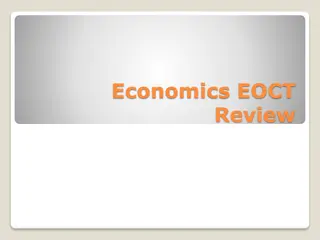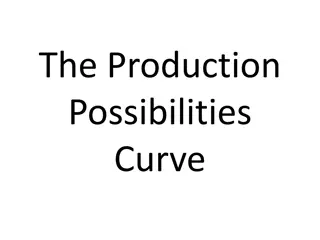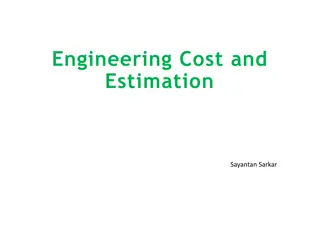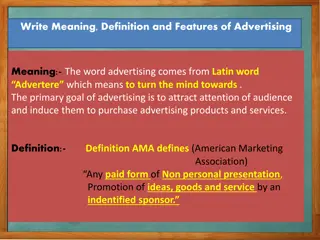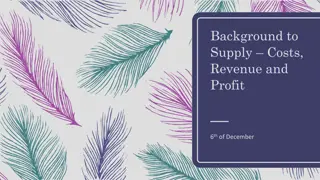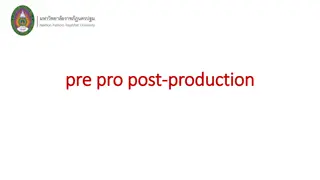Understanding Scarcity, Opportunity Costs, and Production Possibilities
Exploring the foundational concepts of economics, including scarcity, opportunity costs, and factors of production. Delve into efficiency, productive possibilities, and graphing productive possibilities curves to grasp the dynamic interplay between limited resources and unlimited wants in decision-making. Gain insights into maximizing outputs while facing trade-offs and making choices to optimize resource allocation.
Download Presentation

Please find below an Image/Link to download the presentation.
The content on the website is provided AS IS for your information and personal use only. It may not be sold, licensed, or shared on other websites without obtaining consent from the author. Download presentation by click this link. If you encounter any issues during the download, it is possible that the publisher has removed the file from their server.
E N D
Presentation Transcript
Scarcity, Opportunity Costs, and Production Possibilities Curves: Reviewing Chapter 2 through the Homework
Foundational Concepts The economizing problem unlimited wants, limited resources Wants change and expand Economic resources property and human factors
Factors of Production Four Factors Land and things from the land Capital tools, machinery, etc., manufactured items used to produce Labor physical & mental human contributions Entrepreneurial ability initiative, decisionmaking Income is derived from supplying these factors rental/interest income, wages, profits (or losses)
Efficiency Best use of scarce resources Custom defines full employment Productive efficiency Using the least for each product makes it possible to make more overall Allocative efficiency Making what people actually want, the right mix of products
Productive Possibilities The decision of what to produce Assumes full efficiency Assumptions Fixed resources can be reallocated for different products Fixed technology - A frozen moment in time, new products not being introduced Only two goods are being considered, so there is a tradeoff
Productive Possibilities What is the effect of choice? How much of our limited resources do we give to each of two options? Tradeoff between the two One underlying issue is whether we make consumer goods (for immediate satisfaction) or capital goods (for longterm growth)
Graphing Productive Possibilities Curves (PPC) One product per axis, with each point representing some maximum output of the two products Points to the right of the line ( outside ) are impossible, as there aren t enough resources to produce at this level Points to the left of the line ( inside ) are inefficient, representing the economy not working at full potential
Law of Increasing Opportunity Cost Opportunity cost arises because more of one product means less of another The amount sacrificed for one unit = opportunity cost Constant, linear opportunity cost per unit is theoretical only. Part A: #1: A, B & C are all two This is because it reflects (D) constant opportunity cost per unit of Good A.
Law of Increasing Opportunity Cost The (marginal) opportunity cost rises with each unit Could be expressed in money, but in a PPC we re looking at the tradeoff in terms of goods not made The more of a product being produced, the greater marginal opportunity cost thus the shape of the PPC is bowed, with an increasing slope Part A: #2: A is two, B is four, C is six This is reflective of (D) increasing opportunity cost per unit of Good A.
Shape of the PPC Part B: Figure 1.3 is bowed Figure 1.4 is linear
Why is there an Increasing Opportunity Cost? Resources being funneled to one purpose are less suited to it, so they are less productive than they might be for other uses This is the result of imperfect flexibility of resources
Allocative Efficiency & the PPC What is the BEST combination? What should be produced? The optimal point on the line is where MB=MC (marginal benefit=marginal cost) If we can find where MB=MC meet for each of the two products, we can choose the optimal point on the PPC curve
Real World Considerations Unemployment means that an economy can only meet points inside the curve Economic growth ( in terms of quantity of resources, quality, tech advances) shifts the PPC to the right Present choices impact future possibilities Focusing on immediate wants can sacrifice future growth International trade allows countries to specialize and to obtain results outside the curve
Shifting PPC Part C: #3: BD shows a growth in consumer goods from B to D #4: AA shows a contraction of both products from BB #5: CC shows an outward growth shift for both products from BB #6: Point X is outside the realm of possibility with current resources and technology #7: Point Y is inefficient and wasteful, possibly due to unemployment or war



